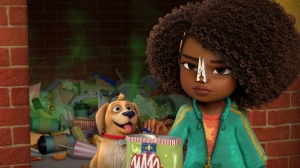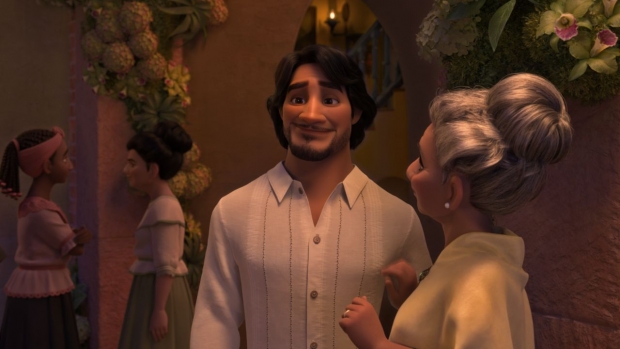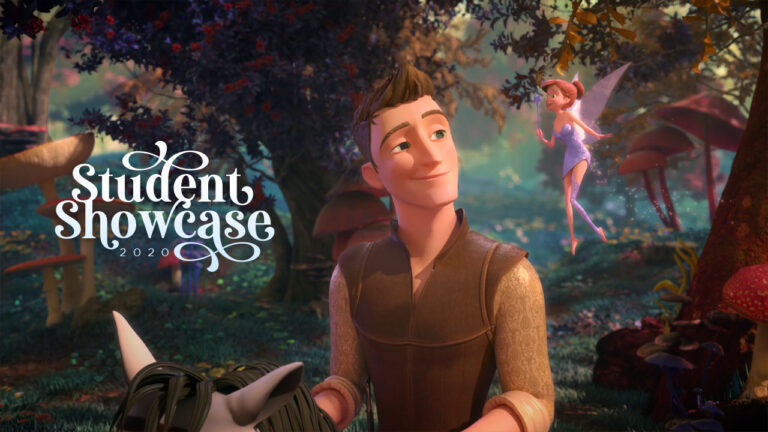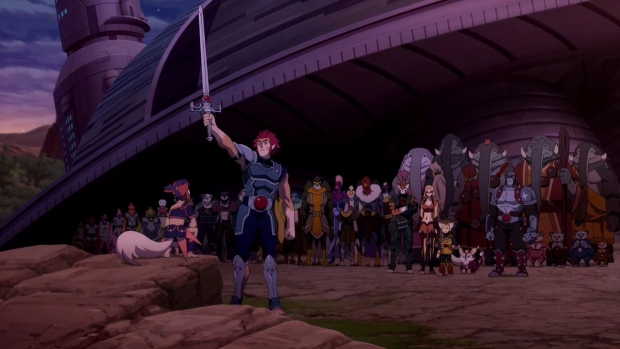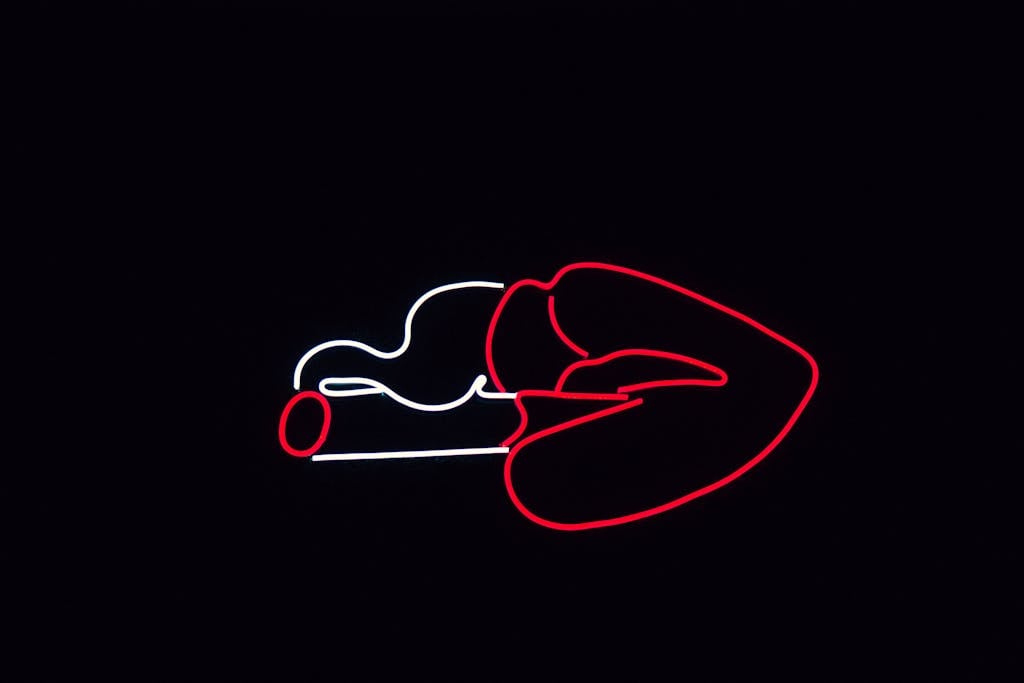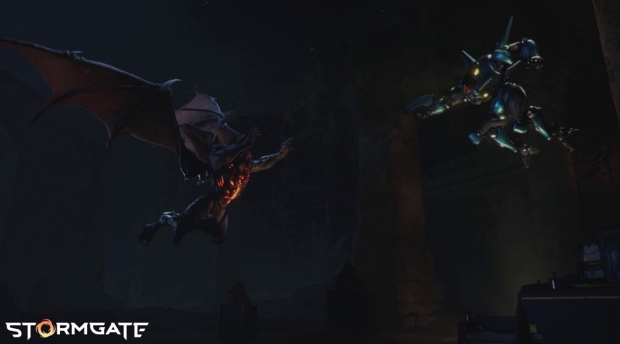In the episode, Karma has a sleepover with her friends who proceed to ask her a series of personal and sometimes uncomfortable questions about her hair, comparing Karma’s thick Black locks to their straight hair. The onslaught of inquiries, while stemming from a place of innocence and curiosity, leaves Karma feeling deeply self-conscious.
A year after the first season’s release, and after taking a much-needed rest to recuperate, Herrera looks back at the work she and the team did with fondness and pride. “The end product, I think, is lovely,” she says. “And if it means we get to see more skin tone varieties like this on TV, and kids get to see it, then it’s worth it.”
“The feedback got really tough with one character in particular,” remembers Herrera. “We wanted the character to have curly hair kind of similar to mine, and the animators kept doing a Shirley Temple kind of curl. So, I took a picture of Shirley Temple, and then I took a picture of a 1920s doll and then some pictures of real people with normally curly hair and I had to cross off the ones that were wrong and put a checkpoint next to the one that was right, so that they would see the difference. It was very emotional because we knew what we were looking for, but the guys that were doing the hair needed more information, something more technical and clearer.”
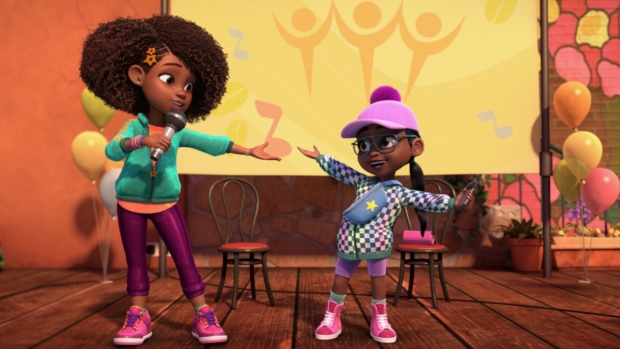
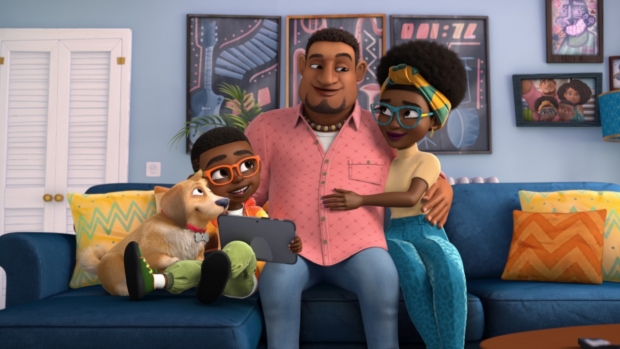
“The smallest detail would bug me,” recalls Herrera. “I would be like, ‘Don’t you see that her skin looks completely off?’ And others would be like, ‘She looks fine to me.’ And I remember just blowing up. After the meetings, I remember my colleagues saying, ‘It’s going to be okay. We’re going to fix it.’ But, to me, it wasn’t about fixing it. I felt offended. Sometimes, when I watch kids’ TV shows, I get so upset because you see this poor child who is the only Black kid in the show, and he has four different skin colors in 10 minutes of an episode. It’s important those details are taken care of, and these kids see that we care.”
“For a long time in animation, when they had to do curly Black hair, they would do an afro and it didn’t matter how it looked,” explains Herrera. “They didn’t think about brushing it, whether it needed to look shiny or have a different layer of color. So, I had to really go in and explain to the animators on our team why certain curls weren’t really natural for Black hair. I felt this big, heavy weight on all our shoulders.”
“The crafting of the characters is really critical, and how they are in relationship to each other really matters as we look at their skin tones,” says Danielle Gillis, currently the Director of Content and Production, but also a Co-Executive Producer. “We didn’t want unintended colorism, or any implications of colorism.”
“From my first day working on this show, we knew we wanted to tell a story about hair,” says Person. “We knew that it was an incredibly important thing to do, and also a huge opportunity for the show to be able to talk about and celebrate Black hair. And not only Karma’s beautiful Black hair, but a diversity of Black hairstyles, which we see across the show.”
Along with the excitement, however, came an overwhelming sense of responsibility to achieve perfection. It was a battle the whole team dealt with on the regular.
It also offered a chance for the Karma’s World team to reflect on and share their own stories of dealing with prejudice and low self-esteem as young Black girls and boys. “A really good example of that is, in our fourth season, we have an episode called ‘Keys the Inventor,’ which is about racial profiling,” shares Person, referencing the episode where Karma’s little brother Keys wants to be an inventor when he grows up but is then told that Black kids can’t be inventors.

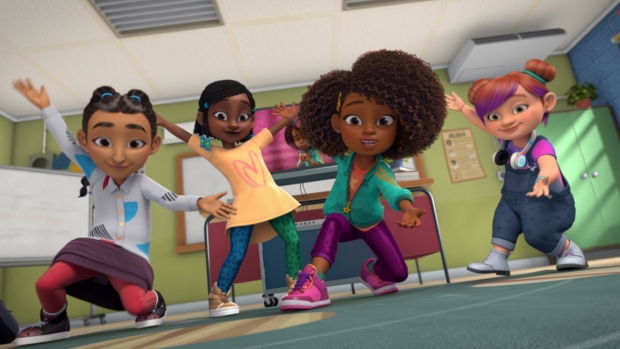
“Instead of outright bullying of someone’s appearance, which is what we started with, we decided to dig deeper into microaggression; where someone says to you, ‘Your hair is different,’ or ‘Your hair is not normal,’ and you know they’re not necessarily trying to hurt you, but they are saying something that does hurt,” says Person. “How to navigate that as a young kid, and when the person saying these things to you is your closest friend, was something new and fresh. It was also thorny, messy, and hard, and a very difficult episode to write.”
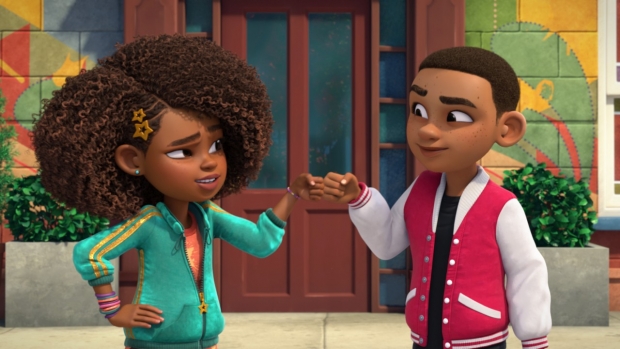
The team would receive feedback from the Perception Institute on the skin tones, such as whether to go lighter or darker depending on the background of each character. They also received research detailing the history of skin tone coloration in entertainment and how it was received by audiences.
“That episode was written by our senior story editor, Keion Jackson, who is a brilliant writer,” continues Person. “In order to allow him to write an episode so deeply difficult and also personal, at the same time that we were all living through the Black Lives Matter uprisings, we made sure that he had the space to do that. So, we took everything else off his plate and gave him a ton of time to research what else was out there about racial profiling for this age group. We gave him time to really sit with the material and rethink the story over and over again.”
“The vision for this show started around 15 years ago when Chris’ daughter Karma, who was six at the time, became obsessed with sneaking into her dad’s studio and trying to record her own rhymes,” explains Person. “Chris realized that kids were really responding to and recognizing the power of hip-hop, and he thought there was a place for kids’ content that could meet kids with that hip-hop, but also with really important messages about everything from body positivity to inclusion, perseverance, and determination. He saw this vision for a show that could do all of that.”
She adds, “But it was fascinating to sit in a room with our writers and hear how many of us have had our own stories with our hair and how we had gone through long and often painful journeys to loving our hair, because we all hadn’t often seen a character on TV that looked like us, who had hair that look like ours, and was celebrating that hair rather than having that hair be made fun of. I love that we were able to not only show multiple hairstyles across Karma’s family, but also different hairstyles on Karma, which I think represents the full beauty and capability of Black hair in a way that was groundbreaking to me.”
Victoria Davis is a full-time, freelance journalist and part-time Otaku with an affinity for all things anime. She’s reported on numerous stories from activist news to entertainment. Find more about her work at victoriadavisdepiction.com.
The pressure was particularly taxing on Herrera, who was having to comb through the tiniest technical details every day to make sure the show didn’t falter visually.
Inspired by Bridges’ own daughter, the series tells the coming-of-age story about a young Black girl and aspiring musical artist named Karma, who pours her soul into songwriting, channeling her feelings into witty, passionate raps that reflect her courage and signature brand of humor. Though she’s only beginning to grasp the emotional power that words and music can have, the big-hearted and deeply empathetic middle schooler knows she doesn’t just want to share her music with the world, she wants to change the world with it.
But, like diamonds formed under the heat and pressure of Earth’s gravity, the stress and emotional turmoil that sometimes came with creating Karma’s World ultimately produced a gem of a show.
Person says that everyone on the team was given time and space to share their stories, their vulnerability, and contribute to the show with their own lived experiences. It was something Person herself benefited from when it came to the episode, “Hair Comes Trouble.”
According to Person, who has worked on other kids’ series like Blaze and the Monster Machines, Karma’s World was “unlike any other job” she’d had in her career in terms of ability to push boundaries and tell stories that have never been told before and, in terms of animation, represent both the Black experience and Black culture of a true Brooklyn neighborhood.
Racial profiling, body shaming, and microaggression among best friends. While these are topics mostly avoided on kids’ animated TV programming, the team behind Netflix’s Karma’s World thinks that kids are already having these conversations and it’s time for adults to catch up.
“It probably wasn’t the best approach production schedule-wise, but we waited until we had all of our characters ready and lit and in sets before we approved any character,” says Herrera. “It was a bit scary, but we really wanted to have everything ready and have this huge Bible set up with the 2D, then the 3D, then the lighting in the daylight and the lighting in an interior so that we could make sure that we had guidelines for the artists to follow from the lightest skin tone to the darkest. It was a task.”
She adds, “Instead of creating from a place of fear, we were creating from a place of joy and excitement of what we could do with this medium.”
“Across the production, we all felt a responsibility, knowing we were going to be groundbreaking and, in a lot of cases, if we were going to be the first, we really had to do it right,” says Person. “If there was no roadmap for something, and we were making the roadmap, we had to do it right so that anyone who was coming behind us would also feel that responsibility to do the same and not cut corners and not do it halfway.”
“And we needed different types of hair, not just a generic helmet on all the characters across the show,” she notes. “To explain why something wasn’t working, at times, was a bit tough. What was normal for me with this head of hair wasn’t for them and they needed more detail, more information for why the hair looks and behaves certain ways. Eventually, we had accumulated this huge Bible of feedback with artists and different teams until we got it the way we wanted. It was a long process.”
Gillis, previously known for producing on Arthur, adds, “We wanted to make something that resonated with kids and families, that was really meaningful to them. So, at the end of the day, we’re always thinking about the kids who are watching and how we model characters for them, situations for them, where they can take away something meaningful. I don’t want to understate that this show is very funny. But we’re presenting material to them in this utopian Brooklyn atmosphere, where you have kids with all different cultural backgrounds, and we felt that responsibility every single minute of every single day.”
Person adds, “Brown Bag Films and 9 Story Media Group have worked on other projects since this, like Eureka!, and we took all the learnings from Karma to create other diverse sets of characters with extremely celebratory hairstyles and skin tones. So, all the incredible work that Elaine and her team did was not just for Karma’s World. It’s something we are building into a whole practice for how we make shows.”
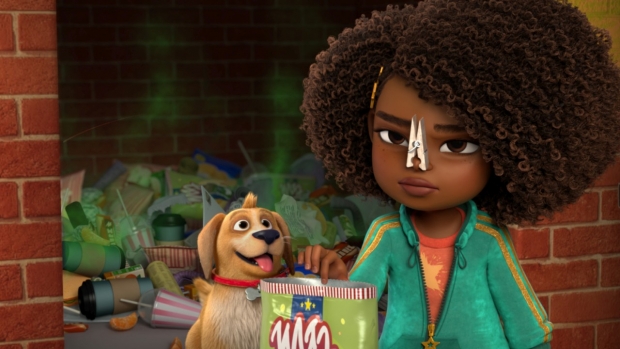
She adds, “Trying to be so truthful to reality, I thought it would come more naturally. But then I realized we don’t have that real reference in 3D. And I remember, more than once, I would see some of the animation come in and I would be like, ‘I’m sorry, but my hair just doesn’t do that. I don’t know how to explain it. It just doesn’t.’”
“They began by showing us the many studies they had detailing how people think of darker-skinned characters as more aggressive or angry or more threatening, things like that,” explains Person. “Often, I feel these kinds of conversations are framed like, ‘How do we not get people mad at us?’ but instead, with them, we were able to say, ‘What’s our opportunity here? We have a huge cast. We have a Brooklyn neighborhood that can be as diverse as the real Brooklyn is. What can we see here that we haven’t gotten to see on screen before?’ And I think they were just such fabulous partners in helping us create this show where we have a darker-skinned female character at the center of all this, and who has a mom who radiates joy and beauty with skin that’s even darker than Karma’s.”

“It became like an education, which is the beauty of this show,” says Gillis. “There’s been an education for our whole team. And now we take that on to our next shows and our next shows. And so, there’s this potential for exponential change.”
Elaine had hoped that, among a team passionate about portraying Black culture realistically on screen, the task of teaching how to animate Black hair would be natural and relatively painless. But that wasn’t always the case.
Karma’s World, created by multi-award-winning American rapper, actor, producer, entrepreneur, and philanthropist Chris ‘Ludacris’ Bridges (Fast and Furious franchise, Fear Factor, Crash) is produced in by Bridges’ production company, Karma’s World Entertainment, in partnership with 9 Story Media Group, and Brown Bag Films. First released in October 2021, the series has already aired four seasons with, Person hopes, more on the way.
“It’s very clear from our research and from the response to Karma’s World that kids are absolutely ready for this,” says Halcyon Person, Karma’s World head writer. “I think there are some adults who are not ready for this. There are a lot of parents who are nervous and scared about having these conversations. And I think those are the people we have to reach and explain to that kids are ready. They’re clamoring for this kind of content. They want to be able to talk about these things. They want to open conversations up with their families and their friends about these kinds of things. And we have to catch up.”
Which is why it was extremely important that the animation of Karma’s hair, as well as the hair of her entire family and other Black characters in the show, had to be as authentic as possible. And the weight of that wasn’t lost on art director Elaine A. Lugo Herrera.
When Herrera and the team started working on the project, she says it was “long before 3DCG had gotten a handle on animating Black hair.” So, the animators had little to no reference to work from and Herrera had few visual aids to ensure that the end result wouldn’t be a “cartoonish afro.”
9 Story Media Group actually went to a middle school and talked with young Black girls about their experiences with their hair, which they said had been called “puffy,” “frizzy,” “messy,” and more. And they all had experiences where their own self-esteem had been knocked down by others who thought that their hair didn’t look “normal.”
Herrera and the team also ran skin tone colors and character art by the Perception Institute, a consortium of researchers, advocates, and strategists who translate cutting-edge mind science research on race, gender, ethnicity, and other identities into solutions that reduce bias and discrimination and promote belonging.

And the process was just as long when it came to characters’ skin tones. On top of a variety of different black hairstyles, looks, and textures, Karma’s World also features a realistically vast amount of different skin tones, with around 10 different shades just for dark-skinned characters.
